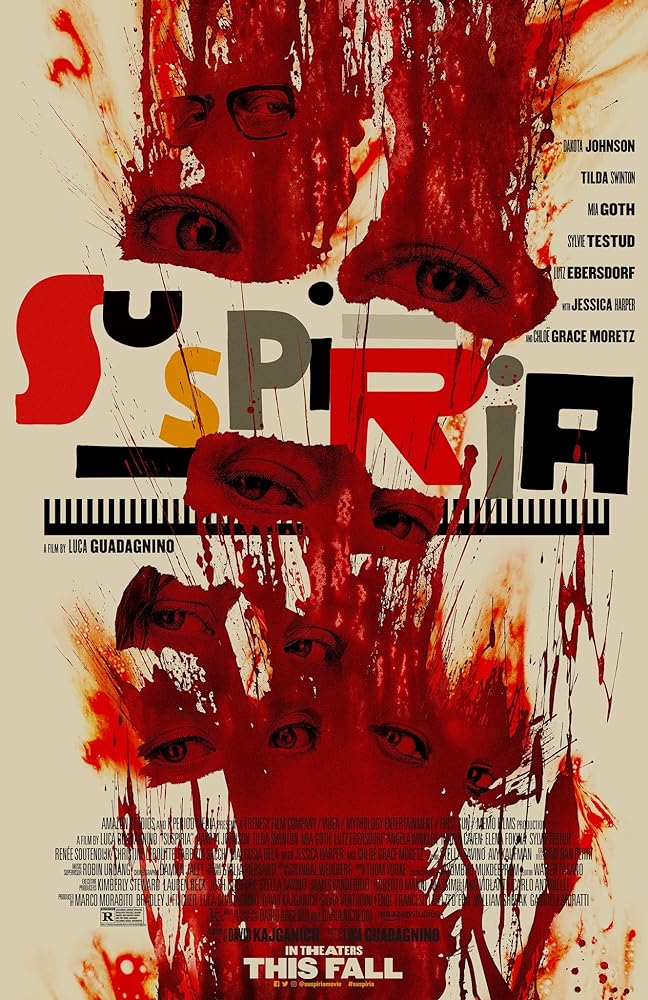
Dario Argento’s 1977 film Suspiria is a horror classic. With its nightmarish imagery, surreal
plot, gorgeous cinematography and haunting music, it’s one of those movies that
teeters on the line between high and low art. Some say it’s a feminist
masterpiece cleverly disguised as a lurid horror fairytale, while others will
tell you it’s just a collection of sounds and visuals Argento thought would
look cool together strung together by a bare-bones plot that horror fans and
cinephiles grafted superfluous meaning to later on, but none of that really
matters. Of all the movies a director would want to remake, you’d think this
would be near the bottom of the list. But Call
Me by Your Name director Luca Guadagnino stood up to the challenge.
Our story follows Susie Bannion (Dakota Johnson), a Mennonite
farmgirl from rural Ohio who left her family behind to become a dancer, moving
to a post-War Berlin to join an elite dance troupe. After a series of mysterious
attacks and disappearances, she discovers the academy, led by its strict instructor
(Tilda Swinton) is a front for a coven of witches manipulating their students into
spells and using them as sacrifices to preserve the immortality of their
matriarch. Meanwhile, a grieving psychotherapist (Tilda Swinton again under
heavy makeup and prosthetics) whose patient (Chloe Grace Moretz) is a former member
of the troupe who went mad and fled, starts investigating after she goes
missing, but his digging starts eventually having bizarre effects on his
psyche.
While the remake more or less follows the basic plot, save
for the extra stuff involving the therapist and a plot twist that I dare not
spoil here, it takes a lot of its cues in the opposite direction. Aesthetically,
it’s a complete reversal. Where the original’s color palate is bright, bold and
saturated, the remake’s is muted and dreary. Where Goblin’s score is hypnotic, dynamic
and overpowering, Thom Yorke’s score is sparse, droning and understated. Much of this comes
from transplanting the setting from Vienna to Berlin, where the political
turmoil from the aftermath of denazification is treated as a backdrop. Where
the fact that the place is run by witches was a big plot twist, here they
reveal it upfront and build the mystery around what exactly they’re trying to
accomplish. Fans looking for a replicate of the aesthetic feel will inevitably
be left disappointed, but that would be a fruitless endeavor, something that
Luca Gudagnino recognizes. His goal in remaking this isn’t to replicate the
look, but to replicate the feelings of dread the movie generates.
One way that this movie captures the primal viscera of the
original is through the dancing. For a movie set in a dance academy, Suspira 77 didn’t have that many dance
numbers. In Suspiria 18, dancing is a
crucial element to some its more magical moments, making this the greatest
example of dance-as-horror since Black
Swan. Stomping, twisting choreography is often used as a conduit for spells,
like in one of its most memorable scenes where Dakota Johnson dances in front
of the troupe for the first time, not knowing that her movements are causing a
rebellious student’s body to grotesquely bend and contort into a human pretzel.
Another common motif is touch. We see Tilda Swinton caress Johnson’s shoulder, brush
her cheek, hold her hands and feet, and with each touch more and more of her
power is transferred to her.
The other thing is does to differentiate itself is be about
something upfront, as opposed to having meaning projected onto it. That’s the
main function of the plot with the therapist, aside from giving Tilda Swinton another excuse
to play two
different characters in the same movie. Guadagnino managed to mine a ton of
substance from this material and was able to recontextualize it in a profound
way. While the Berlin setting is mainly treated as window dressing and the role
of the psychotherapist is beefed up substantially, it changes the context of
the story significantly. While the academy is a sort of island in the sea of
discord that was post-war Germany, and part of the therapist’s arc is wrestling
with his past as a former Nazi and how it led to the separation of him and his
wife (played by Suspiria ‘77 star
Jessica Harper), a specter that lingers over the city and infiltrates the witch’s
sanctuary when he lets himself in. It’s hard not to find parallels between this
and current toxic political climate and the push for Hollywood to hear and
believe the cries of women in the wake of the Me Too movement.
But where this truly keeps the spirit of the original is in
its depiction of witchcraft. Although they’re honest about the dance academy
being a front for a coven of witches upfront so it can get to the thematic
meat, the buildup to what’s really going on remains as striking and frightening.
Susie’s enhanced backstory as a runaway Mennonite also brings themes of
sexuality, religion and repression to the foreground, which all ties in to an
endgame twist that recontextualizes the whole movie, but revealing it would be
giving away the game.
Bottom line, while Suspiria bares a passing resemblance to
its parent, it steps out of its shadow and sets a track of its own. It’s
audacious, intense, and divisive by design, and utterly unforgettable. Some may
find it sacrilege, albeit for completely different reasons, but that’s all part
of the fun, isn’t it?
8/10
No comments:
Post a Comment